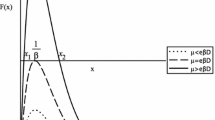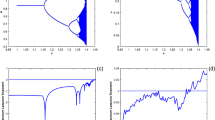Abstract
The research presented in this paper compares the occurrence of limit cycles under different bifurcation mechanisms in a simple system of two-dimensional autonomous predator–prey ODEs. Surprisingly two unconventional approaches, for a singular system and for a system with a center, turn out to produce more limit cycles than the traditional Andronov–Hopf bifurcation. The system has a functional response function which is a monotonically increasing cubic function of x for \(0\le x\le 1\) where x represents the prey density, and which is constant for \(x>1\). It acts as a proxy for investigating more general systems. The following results are obtained. For the Andronov–Hopf bifurcation the highest order of the weak focus is 2 and at most 2 small-amplitude limit cycles can be created. In the center bifurcation cases are shown to exist with at least 3 limit cycles. In the singular perturbation cases are shown to exist with at least 4 limit cycles and in some cases an exact upper bound of 2 limit cycles is obtained. Finally we indicate how the conclusions can be extended to more general systems. We show how an arbitrary number of limit cycles can be created by choosing an appropriate functional response function and growth function for the prey. One special situation is the system with group defense: the three bifurcation mechanisms typically produce less limit cycles if a group defense element is included.





























Similar content being viewed by others
References
Andronov, A.A., et al.: Theory of Bifurcations of Dynamic Systems on a Plane. Halsted Press, New York (1973)
Arnold, V.I.: Experimental Mathematics, pp. 1–158. MSRI Mathematical Circles Library and the American Mathematical Society, Providence, Rhode Island (2015)
De Maesschalck, P., Dumortier, F.: Canard solutions at non-generic turning points. Trans. Am. Math. Soc. 358(5), 2291–2334 (2006)
De Maesschalck, P., Dumortier, F.: Canard cycles in the presence of slow dynamics with singularities. Proc. R. Soc. Edinb. Sect. A 138(2), 265–299 (2008)
De Maesschalck, P., Dumortier, F.: Classical Liénard equation of degree \(n \ge 6\) can have \([\frac{n-1}{2}]+2\) limit cycles. J. Differ. Equ. 250, 2162–2176 (2011)
De Maesschalck, P., Dumortier, F., Roussarie, R.: Cyclicity of common slow-fast cycles. Indag. Math. 22, 165–206 (2011)
De Maesschalck, P., Dumortier, F., Roussarie, R.: Canard cycle transition at a slow-fast passsage through a jump point. C. R. Math. Acad. Sci. Paris 352(4), 317–320 (2014)
Dumortier, F., Roussarie, R.: Canard cycles and center manifolds. Mem. Am. Math. Soc. 121(577) (1996)
Dumortier, F., Roussarie, R.: Multiple canard cycles in generalized Liénard equations. J. Differ. Equ. 174(1), 1–29 (2001)
Gause, G.F.: The Struggle for Existence. Williams and Wilkins, Baltimore (1934)
Han, M., Wang, C.: On two stability problems of generalized Liénard equations (in Chinese). Appl. Math. JCU (Ser. A) 12(3), 273–278 (1997)
Han, M.: Bifurcation Theory of Limit Cycles, pp. 1–360. Alpha Science, Oxford (2017)
Holling, C.S.: The components of predation as revealed by a study of small-mammal predation of the European pine sawfly. Can. Entomol. 91, 293–320 (1959)
Kooij, R.E., Zegeling, A.: Predator–prey models with non-analytical functional response. Chaos Solitons Fractals 123, 163–172 (2019)
Kooij, R.E., Zegeling, A.: Co-existence of a period annulus and a limit cycle in a class of predator-prey models with group defense. Int. J. Bif. Chaos (2021)
Zegeling, A., Kooij, R.E.: Singular perturbations of the Holling I predator–prey system with a focus. J. Differ. Equ. 269, 5434–5462 (2020)
Zegeling, A., Kooij, R.E.: Uniqueness of limit cycles in polynomial systems with algebraic invariants. Bull. Aust. Math. Soc. 49, 7–20 (1994)
Zhang, Z., et al.: Qualitative Theory of Differential Equations, vol. 461. American Mathematical Society, Providence (1992)
Zhuo, L.: Periodic solutions for several types of certain planar differential equations (in Chinese). MSc. thesis, Shandong Inst. of Mining and Tech. (1996)
Author information
Authors and Affiliations
Corresponding author
Additional information
Publisher's Note
Springer Nature remains neutral with regard to jurisdictional claims in published maps and institutional affiliations.
Rights and permissions
About this article
Cite this article
Zegeling, A., Kooij, R.E. Several Bifurcation Mechanisms for Limit Cycles in a Predator–Prey System. Qual. Theory Dyn. Syst. 20, 65 (2021). https://doi.org/10.1007/s12346-021-00501-w
Received:
Accepted:
Published:
DOI: https://doi.org/10.1007/s12346-021-00501-w




